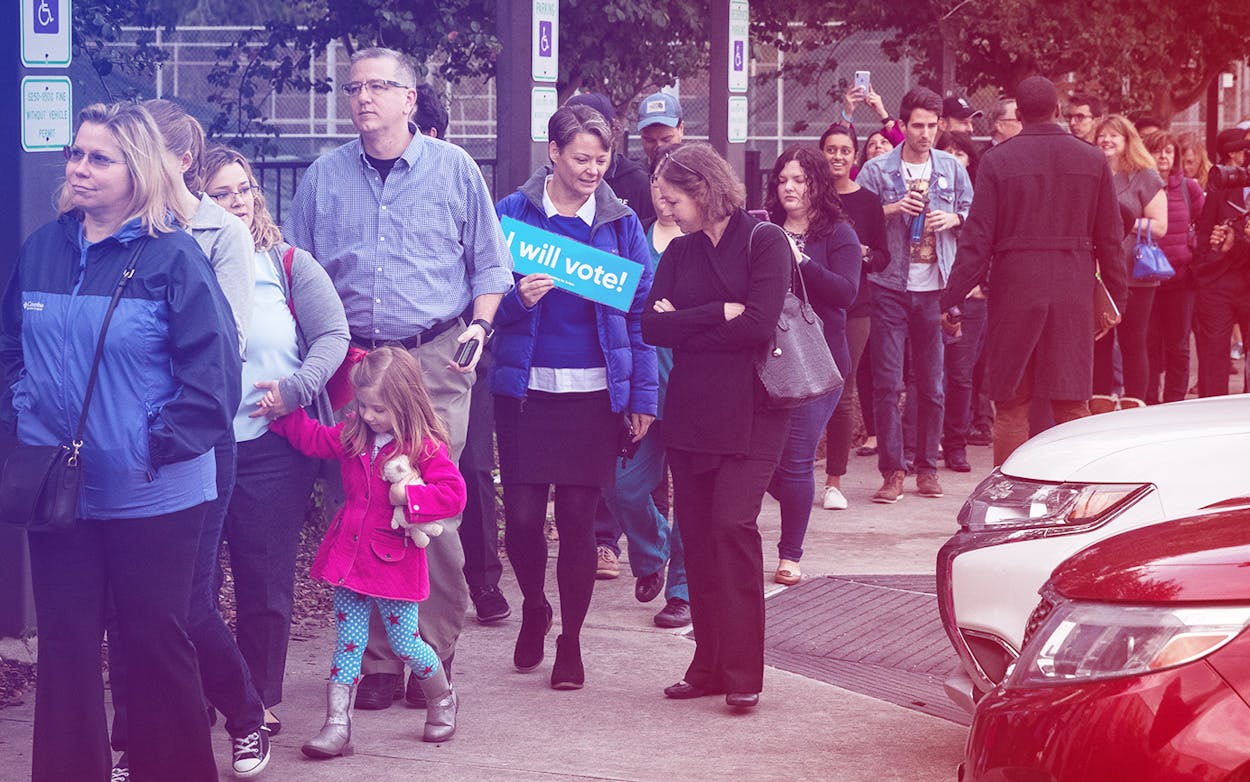There are few election contests in America this year that have become as nationalized as Democrat Beto O’Rourke’s challenge to the re-election of Republican U.S. Senator Ted Cruz, and Texas voters are responding. The first two days of early balloting have seen a voter turnout that is at presidential election levels. Already, it is clear that overall turnout will blow the 2014 election out of the water. The cumulative in-person early vote and mail-in ballots already has exceeded the 2016 presidential election turnout in Dallas, Collin, Denton, El Paso, Williamson and Collin counties. In Texas’s 30 most populated counties, the early vote and mail in ballots on day two totaled 1,187,007 ballots.
The unanswerable question at this point is whether Texas voters are validating President Trump by re-electing Cruz? Or is this a monumental upset in the making by O’Rourke, possibly breaking an unending cycle of Democratic losses in statewide elections that date back to 1996?
Several more days of early voting will pass before a clear picture starts to emerge, but it is worth noting that during the 2016 presidential contest, 73 percent of all the Texas votes were cast during the early voting period. In the 2014 governor’s race, early ballots were 54 percent of the total. Analysis of early voting is made possible by comparing the names of persons who voted in past elections to those who vote in the current election.
Not surprising, the most partisan Texans—those with a history of voting in either the Republican or Democratic primary—cast the most votes on the first day. People with a party primary voting history cast 69.9 percent of the votes on Monday. Past Republican primary voters held a slight edge over the Democrats, casting 36.1 percent of the votes in major urban counties to the Democrats’s 33.8 percent, according to data compiled by Republican consultant Derek Ryan. The Republican turnout was up four percent over the first day of the 2014 midterm election, while Democratic turnout nudged up less than half a percentage point. That may be partly explained by the fact President Trump visited Texas on Monday to stir up voter turnout for the re-election of Cruz. But O’Rourke held major get-out-the-vote rallies that day around Texas as well.
The real wild card to Monday’s voting was that almost one out of every five ballots cast were by people who vote in general elections with no party primary history, while between five and nine percent—depending on the county—had no previous history of voting at all. Because Texas does not have party registration, there is no good way to know whether these voters are leaning toward Cruz or O’Rourke. But the new voter numbers probably favor O’Rourke because he has been working to gain support from non-voters: young people and Hispanics. On the flip side, general election-only voters in Texas have favored the Republican candidate for years.
For O’Rourke, even a traditionally Republican county like Montgomery just north of Houston, might be significant. O’Rourke is not likely to carry the county, but, if he can increase the Democratic turnout, that adds into his statewide total. According to Secretary of State numbers, first-day turnout in Montgomery increased from 3,949 in the 2014 midterm election to 11,180 this year. Ryan found 61 percent of Monday’s vote came from Republican primary voters. However, O’Rourke held a large rally there that day, and nine percent of the Monday vote in Montgomery County was cast by new voters.
Then there’s reliably Democratic Hidalgo County, which more than doubled its first-day voting from 2014. Nine percent of its turnout also was from first-time voters, and 18.7 percent of the vote was from people who vote in general elections but not primaries. During the 2014 midterm, Hidalgo had a dismal turnout of a mere 25 percent of its registered voters in the governor’s race.
The biggest downside overall for O’Rourke was that voters over the age of 40 made up the bulk of the first day vote. Also, to win statewide against the heavily Republican rural and exurban counties, O’Rourke needs major victories in Bexar, Dallas, El Paso, Harris and Travis counties.
However, Democratic consultant Keir Murray of Houston noted for me that early voting usually trends Republican during the first several days because the weekday hours make it easier for retired people to vote. He said Democrats are seeing positive numbers for Harris County and Houston. “Fifteen percent of Harris County voters (Monday) were under age 35, as compared to eight percent of the 2014 electorate,” he wrote, via Twitter messaging. “Over early vote period, electorate becomes younger, more hispanic, less frequent participants, etc. We will see.”
https://twitter.com/houtopia/status/1054832402239913984
Early voting continues until November 2 for the November 6 election.
- More About:
- Politics & Policy
- Ted Cruz
- Beto O'Rourke






